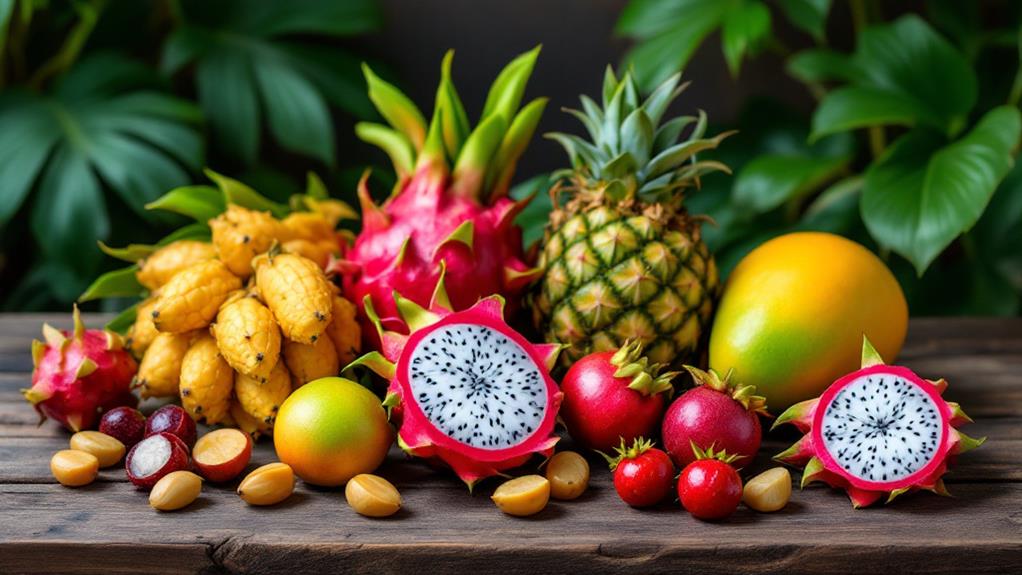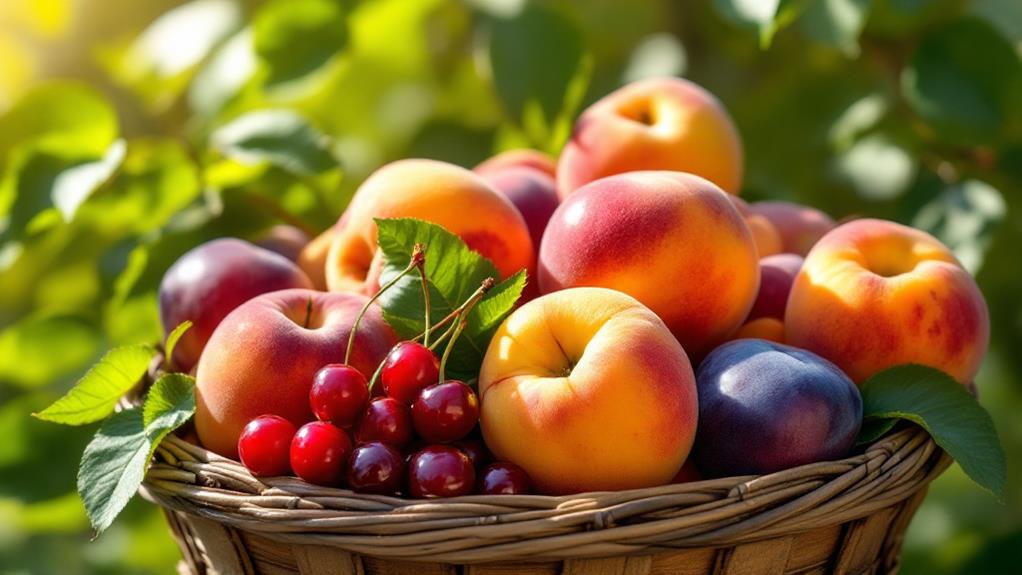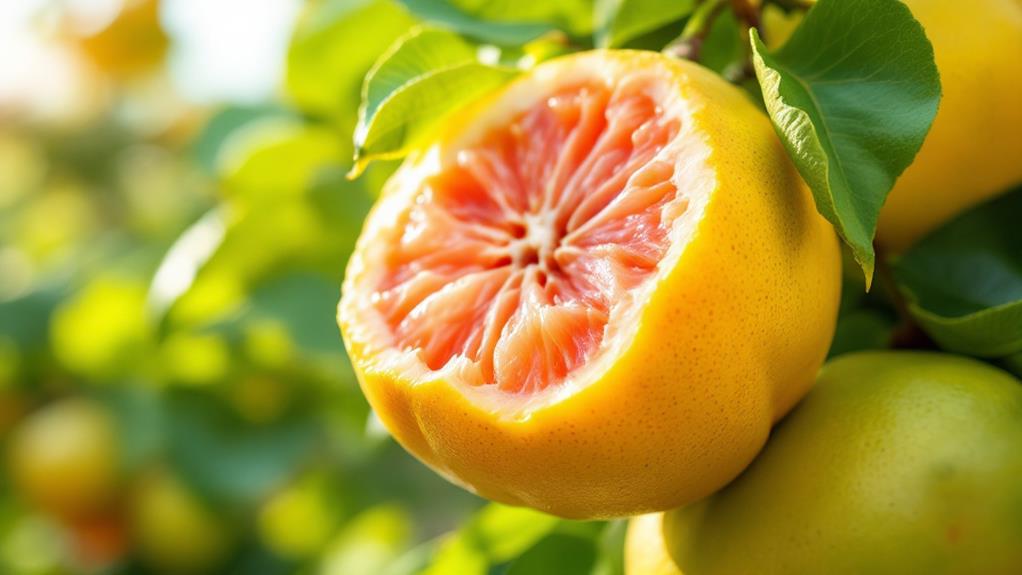Everything You Need to Know About Ambrosia Apples: The Sweetest Apple
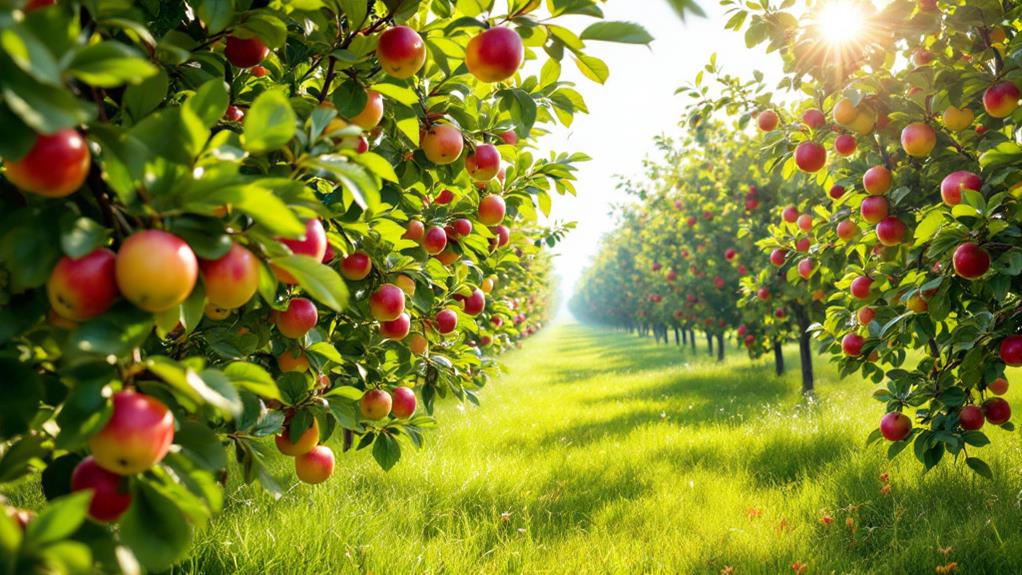
You'll find Ambrosia apples irresistible with their honey-sweet flavor and juicy, crisp texture. Originating from a chance seedling in British Columbia in 1987, these apples are believed to combine traits from Jonagold and Golden Delicious. With a stunning pink-tinged orange flush, they're as delightful to look at as they are to eat. They thrive in semi-arid climates, requiring warm days and cool nights. Ambrosias are perfect for eating fresh or adding natural sweetness to salads, baked goods, and smoothies. When stored properly, they maintain their flavor and texture, offering nutritional benefits all year long. Uncover why these apples have a loyal fan base.
Discovery and Origin
In the rich apple-growing region of British Columbia's Similkameen Valley, the Ambrosia apple made its unplanned debut in 1987. Uncovered by Wilfrid and Sally Mennell, this remarkable apple emerged as a chance seedling in their orchard. While the exact parentage of the Ambrosia isn't definitively known, it's believed to be a cross between the Jonagold and Golden Delicious types, with a hint of Red Delicious traits. This unique combination contributes to its appealing sweet flavor.
The Mennells recognized the potential of this naturally occurring apple, given its delightful taste and appealing appearance. They decided to pursue commercial propagation, partnering with Summerland Varieties Corporation in 1993. This collaboration marked the beginning of a quest that would see the Ambrosia apple's availability increase considerably in the market. Today, it's a beloved choice among consumers who appreciate its honey-like sweetness without the usual acidity found in other apples.
The Ambrosia apple has since gained popularity and is now cultivated in multiple regions, including the U.S. and Canada. Its progress from a chance seedling in the Similkameen Valley to a staple in the apple market is truly remarkable.
Flavor and Texture
Boasting an exceptionally sweet flavor profile, Ambrosia apples enchant with honeyed notes and subtle hints of pears and floral aromas. This unique flavor makes them a favorite for fresh eating. When you take a bite, you'll experience a firm and crisp texture that offers a tender crunch, striking a balance between softness and firmness reminiscent of Golden Delicious apples. Unlike tart varieties, Ambrosia apples lean towards a sweeter side, which might be a delightful surprise for your taste buds.
The juicy nature of these apples adds to their appeal, providing a revitalizing burst of flavor with every bite. Their pale gold flesh pairs beautifully with their smooth, glossy skin, which features an eye-catching pink-tinged orange/red flush over a yellow background. Here are a few highlights of the Ambrosia apple:
- Sweetness: Dominated by honeyed notes, perfect for those with a sweet tooth.
- Texture: Firm yet tender, offering a satisfying crunch.
- Juiciness: Exceptionally juicy, enhancing the eating experience.
- Aroma: Subtle floral and pear hints that enhance its flavor.
- Appearance: Striking color contrast, making it visually appealing.
For ideal texture, chill them; prolonged room temperature might diminish their crispness.
Growing Conditions
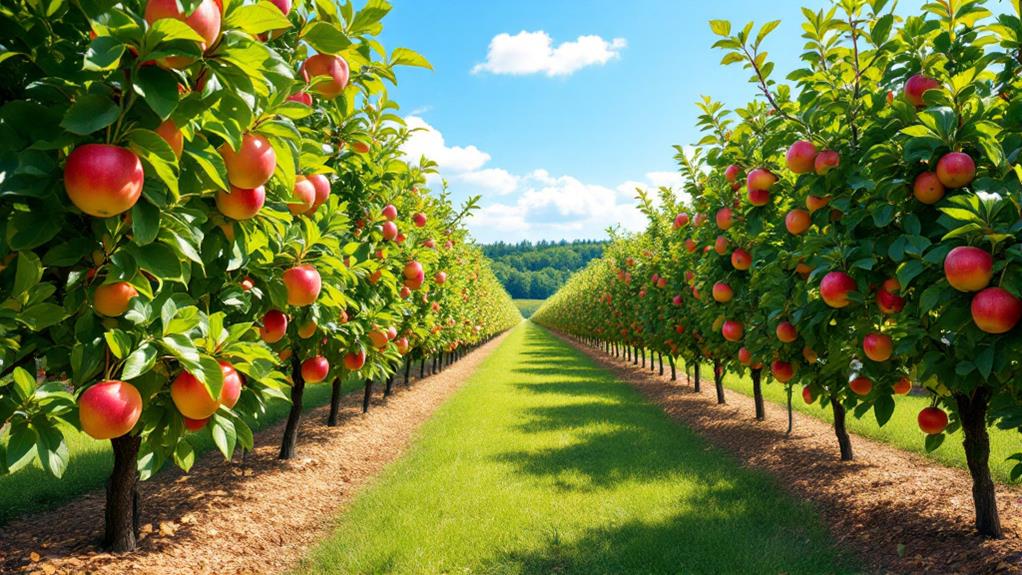
To cultivate Ambrosia apples successfully, focus on their specific growing conditions. These apples thrive in the semi-arid climates of the Similkameen and Okanagan valleys in British Columbia, Canada. This region's warm days and cool nights support their growth, alongside grapevines and other warm-climate crops. Selecting the right rootstock is essential, and for commercial orchards, the best rootstock is M26. It's preferred over M9 due to better performance, although M26 availability for private growers is limited.
Ambrosia apples are cold-hardy, yet they need protection from frost during their growing season. This resilience allows them to flourish in different regions. They're classified as a mid to late-season apple variety, with harvesting typically happening in the fall. The timing of the harvest is vital, as these apples are managed as a club apple to maintain quality and consistency in the market.
While Ambrosia apples are known for their delectable sweetness, ensuring they reach peak maturity involves careful monitoring. By understanding and applying these specific growing conditions, you can cultivate Ambrosia apples that are not only sweet but also of high quality, ready for enjoyment or cold storage.
Handling and Storage
Proper handling and storage of Ambrosia apples are important to maintain their quality and prolong shelf life. To keep these delicious apples fresh, follow fundamental guidelines. Initially, always guarantee Ambrosia apples stay dry, washing them only just before use. This practice helps prevent spoilage and keeps the apples at their best. When storing, handle with care to avoid bruising. Dropping or mishandling can shorten their shelf life markedly, so gentle handling is key.
Store Ambrosia apples within a recommended temperature range of 32°F to 40°F. Positioning them in the front of the cooler guarantees consistent temperature and ideal storage conditions. It's also critical to protect Ambrosia apples from strong odors to avoid flavor absorption. Keep them away from items like onions, and limit their exposure to ethylene-producing fruits to maintain their texture and freshness.
Regularly monitor your storage conditions to guarantee the apples stay fresh for as long as possible. Consider these storage tips:
- Keep apples dry and wash only before use.
- Handle gently to prevent bruising.
- Store at 32°F to 40°F.
- Avoid strong odors and ethylene.
- Monitor conditions regularly for freshness.
Nutritional Benefits
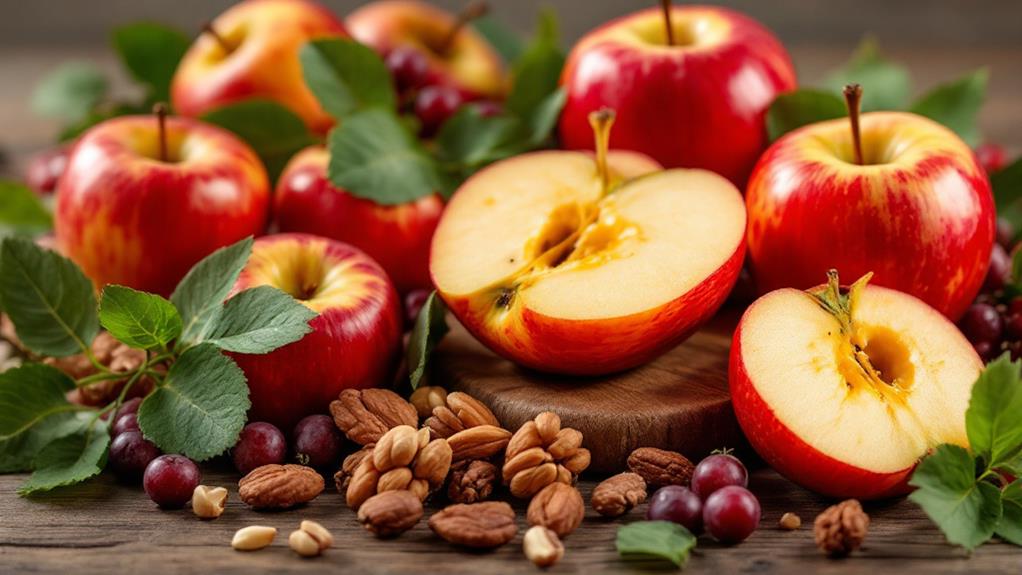
Although often enjoyed for their sweet and crisp taste, Ambrosia apples are also packed with nutritional benefits that make them a smart choice for healthy eating. These apples are an excellent source of dietary fiber, which aids in digestion and helps you maintain a healthy weight. By promoting feelings of fullness, they support better portion control and general eating habits.
Ambrosia apples are rich in vitamin C, which is essential for improving your immune system and keeping your skin healthy and lively. A single apple can provide a significant portion of your daily vitamin C needs, making it an easy and delicious way to support your health. Furthermore, Ambrosia apples contain potassium, a key mineral that supports heart health and proper muscle function.
With a low calorie count, Ambrosia apples make for a perfect healthy snacking option. They allow you to indulge your sweet tooth without the guilt, helping you stay on track with your dietary goals. Beyond these nutrients, each apple contains important trace elements like boron, phosphorus, and magnesium, contributing to different metabolic processes. Incorporating Ambrosia apples into your diet can improve your general well-being effortlessly.
Culinary Uses
Beyond their impressive nutritional profile, Ambrosia apples shine in the culinary world with their adaptability and lively flavor. Their sweet flavor and crisp texture make them a top choice for numerous culinary uses, regardless of you're enjoying them fresh or incorporating them into your favorite recipes.
For fresh eating, Ambrosia apples are a invigorating snack straight from the fridge. They're perfect for salads and slaws, offering a natural sweetness and lively color without needing extra dressings. Thanks to their resistance to browning, they maintain an appealing look and taste in fruit salads and cheese platters.
When it comes to baking, Ambrosia apples excel by holding their shape well, making them ideal for pies, muffins, and other dessert recipes where you desire that sweetness. Their adaptability doesn't stop there; they pair beautifully with cheeses and meats, enhancing both sweet and savory dishes. You can even toss them into smoothies for added sweetness and nutritional value.
Here are some culinary uses to try with Ambrosia apples:
- Fresh eating straight from the fridge
- Adding to salads and slaws
- Baking in pies and muffins
- Pairing with cheeses and meats
- Blending into smoothies for sweetness and nutrition.
Consumer Insights
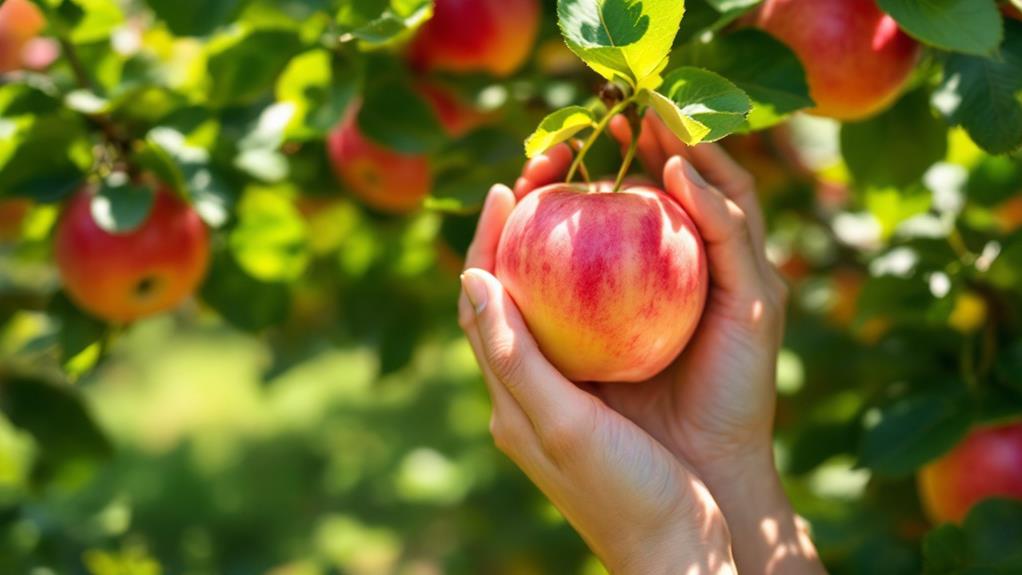
In regard to Ambrosia apples, many consumers have fallen in love with their sweet flavor and crisp texture. These attributes have cultivated a loyal following, with many rating their general satisfaction around 3.5 out of 5. You'll find that consumer preference often leans toward Ambrosia over other varieties like Gala and Honeycrisp, especially when Honeycrisp apples are perceived as too tart.
However, consumer insights reveal quality variability in Ambrosia apples. While fresh ones are praised as delicious and juicy, some can disappoint with a mealy texture due to poor storage conditions. This inconsistency highlights the importance of sourcing from reputable growers who maintain the apples' premium quality. If you're exploring different options, the Ambrosia Gold variant might be worth trying, as some consumers report it as superior in taste and texture.
When selecting Ambrosia apples, understanding these consumer insights can guide your purchase. Look for signs of freshness to enjoy their peak sweet flavor and crisp texture. By being mindful of quality variability, you can improve your experience and perhaps even uncover your own preference for Ambrosia or Ambrosia Gold apples.

